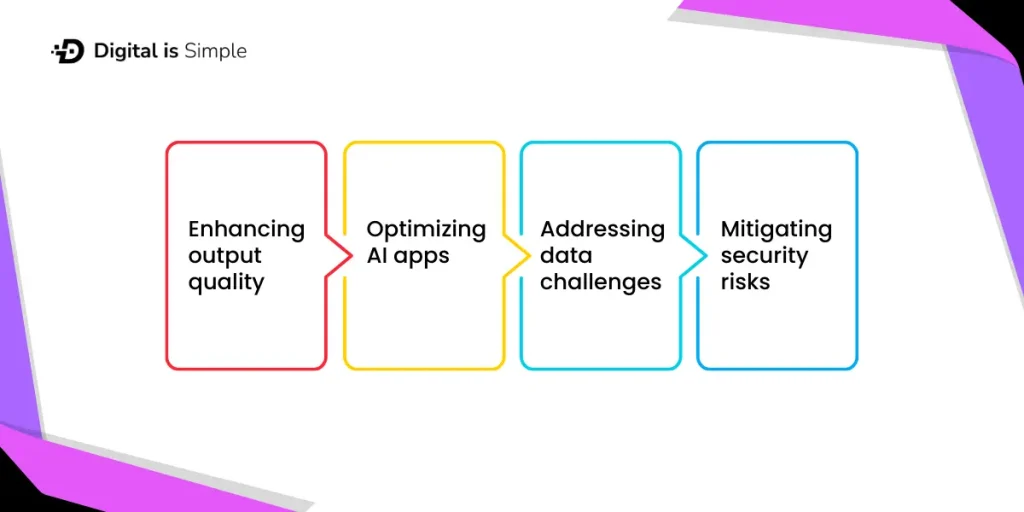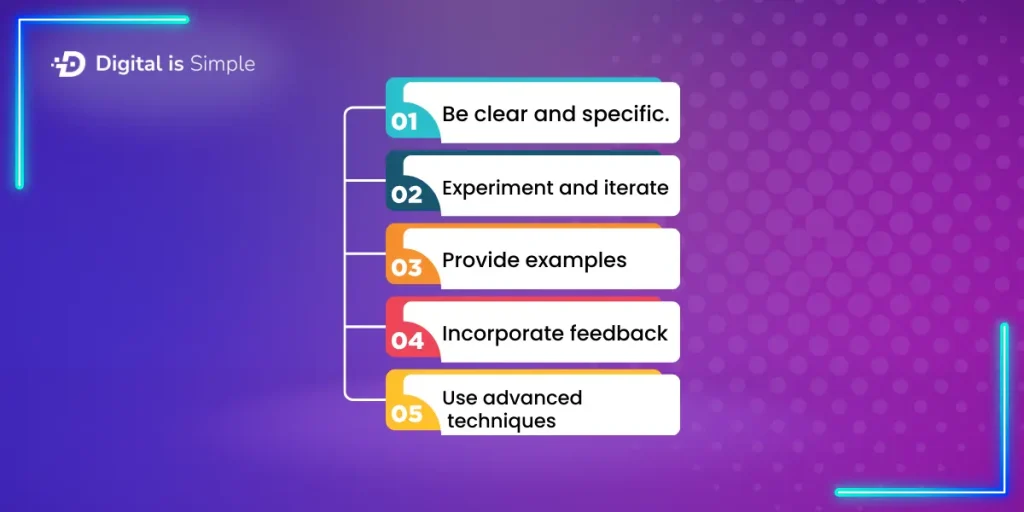The smart world is taking up by storm with smart AI capabilities. And the secret to using such smart AI tools is to command well. As, if you can’t write the accurate prompts you can’t get the perfect output. So, the art of AI prompt engineering is the key to success in AI tools. If you want to how to write these prompts, then let’s dive in to know more.
An overview of prompt engineering
Generative AI has transformed interactions with technology, including text, images, and videos. To produce outputs, you can use AI prompt engineering with generative AI technologies. Whether it’s leveraging NLP in ChatGPT or DALL-E to optimize LLMs for faster engineering.
Consider using ChatGPT to generate a professional summary for your resume. A simple prompt, such as, “Write a professional summary for a marketing analysis.” Use a more conversational tone to help tailor the output to your specifications.
Why is prompt engineering important in Generative AI?
Here are some reasons to use prompts with AI models.

Enhancing output quality
Effective rapid engineering guarantees that generative AI outputs meet objectives. A well-designed inquiry decreases opacity, allowing the AI to generate exact responses.
Optimizing AI apps
AI engineers use prompt engineering AI tools to refine code like chatbots and customer bots. Such as, in legal technology, prompts can instruct AI to design contracts with requirements.
Addressing data challenges
In today’s data-driven world, manually processing massive datasets is wasteful. Generative AI application development services can speed up the process by extracting insights.
Mitigating security risks
Deep learning AI prompt engineering can discover and resolve security concerns. Such as quick injection attacks. These attacks use flaws in AI reasoning to alter results. However, well-crafted prompts can assist in mitigating dangers to ensure AI security.
How to nail prompt engineering techniques for your business?
Here are some of the basic techniques you can use with Gen AI
Zero-shot prompting
This easy way entails giving the AI direct commands without providing examples. Zero-shot prompting is effective for simple activities. Such as answering factual inquiries and creating basic lists.
Example:
‘List 3 best ab exercises’
Few-shot prompting
Here, you submit a few instances to help the AI respond. This strategy is for difficult jobs when the model needs data to grasp the desired output.
Example: How to write a product description:
- Concentrate on the primary benefits.
- Use engaging wording.
- Add a call to action. Now create a product description for a smart thermostat.
Chain-of-Thought prompting
This strategy encourages AI in cybersecurity to divide complex issues into intermediate phases, which improves reasoning and accuracy.
For example, if a train runs at 60 miles per 2 hours, how will it cover the remaining distance of 100 miles? Explain your rationale step by step.”
Prompt chaining
It breaks down a complex task into smaller subtasks. And feeding the Quantum AI‘s outputs from one stage to the next. This strategy increases the dependability and consistency of complex procedures.
Example:
The first phase: ‘Draft an outline for a blog about sustainable travel.’
The second phase: ‘Write the introduction based on the outline.’
Step-by-step to AI prompt engineering process
Here is the step-by-step guide to make the prompts.

Be clear and specific.
This strategy encourages AI to divide complex issues into intermediate phases. Because being clear will help to fight any confusion. So, having clarity will help to get accurate prompts.
Experiment and iterate
Generative AI thrives on experimentation. Test different versions of the same question to see what works best. Add or change instructions, tone, or length to improve the output.
Example:
‘Send a professional email to a new client outlining our digital marketing services. Use a friendly but formal tone.’
Provide examples
Providing examples can help the AI achieve the intended outcome. Consider the following inspiring quote: ‘Success is not the key to happiness.’ And you can command to create three more quotes like these.
Incorporate feedback
Prompts can develop through engagement. To improve the findings, provide low-code/no-code on the AI’s initial responses.
For example:
Initial response: ‘Too formal.
Feedback: Use a conversational tone.’
Use advanced techniques
To handle jobs, consider sophisticated solutions such as CoT prompting and prompt chaining. These strategies enable you to steer AI through multi-step processes for nuanced results.
Real-world uses of prompt engineering across businesses
Let’s look at some business sectors that use prompts for further advancement.
Service
Businesses include customer support with AI enhancement to help the user queries. Firms can guarantee that chatbots respond correctly by creating useful prompts. Prompts can help AI systems understand the intent behind user inquiries. Enabling the chatbot to detect when an inquiry is too complex ensures a smooth transition.
Marketing
Content creators use prompt engineering to increase productivity and creativity. Prompts can help AI generate social captions, brainstorm ideas, and create content. They also encourage various perspectives.
Ensure brand consistency by including tone, style, and messaging in the prompts.
Education
AI-powered learning platforms employ prompt engineering to provide personalized experiences. Provide explanations, answer questions, or adjust data for student’s comprehension. Moreover, creating quizzes, flashcards, and plans based on individual objectives.
Healthcare
The medical field integrates rapid engineering to enable AI systems to aid with patient education. Such as, prompts might aid AI in interpreting medical imaging to identify concerns. In healthcare, chatbots employ prompts to answer patients’ questions. And provide information about prescriptions or symptoms.
Gaming
Game creators employ prompt engineering to create tales, dialogues, and environments. These prompts help AI create a variety of levels, characters, and settings. AI-powered NPCs employ prompts to dynamically respond to player activities.
The potential future of prompt engineering
Here is what to watch out for prompt engineering future.
Multimodal prompts
The text, graphics, and code in a single prompt will broaden the chances for generative AI apps.
Adaptive prompts
Dynamic prompts that adapt to context or user reaction will make AI interactions more intuitive.
Ethical considerations
Prompt engineering will be crucial in assuring fairness, transparency, and inclusivity. While remaining consistent with developing AI ethics standards.
Conclusion:
Prompt engineering is a great tool for closing the gap between human and machine intelligence. Organizations with this skill may realize the full promise of generative AI. Whether you’re new to AI or an experienced developer, fine-tuning your prompts is a critical step. Or even you can consult AI software development services for more assistance.
FAQs
1. What is the purpose of prompt engineering in gen AI systems?
Prompt engineering is the activity of designing inputs for AI technologies that provide the best results.
2. What is AI prompt engineering?
Prompt engineering can be defined as the process of creating and adjusting inputs to elicit desired answers from generative AI models. It’s similar to talking successfully with the AI in order to maximize its potential and achieve specified goals.
3. What is the primary challenge in prompt engineering?
The goal is to strike the perfect balance between being clear and being overly specific. Prompts must provide enough information for the AI to comprehend what to do while without limiting its flexibility. If the prompts are too vague, the AI may produce weirder answers.
4. What exactly is the duty of a prompt engineer?
Some frequent job tasks are: Designing and creating prompts for a variety of applications, such as text production, translation, question answering, and creative writing. Collaborate with product teams, data scientists, and engineers to understand user requirements and translate them into effective prompts.
5. Which strategy is not employed in quick engineering?
Adding unnecessary information to the question can confuse the model, resulting in fewer accurate or coherent responses.
